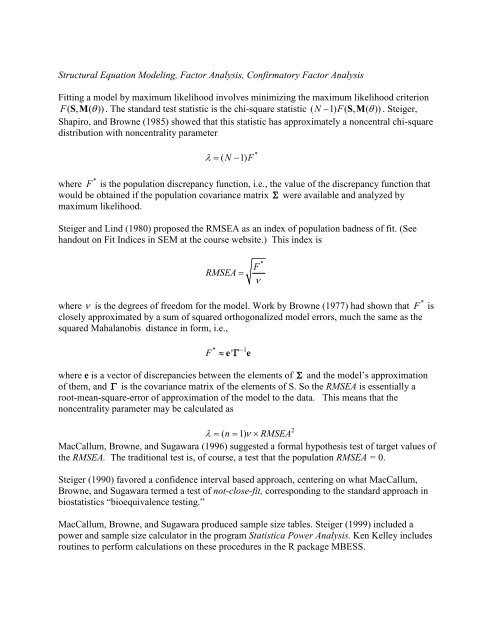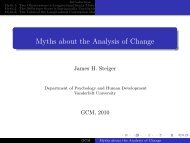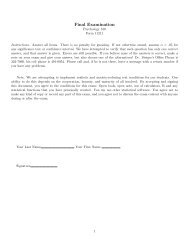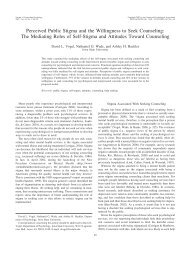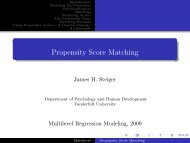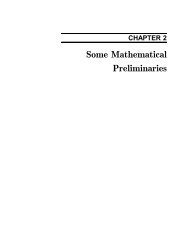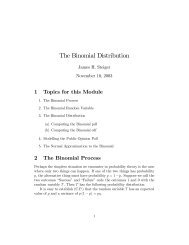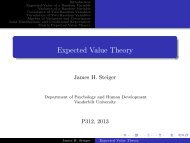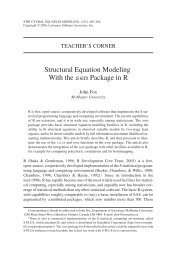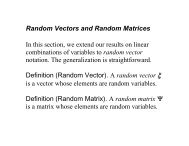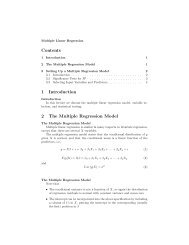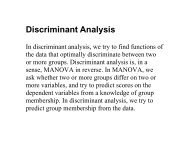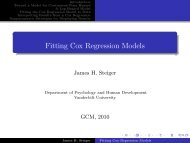Power Analysis Notes - Statpower
Power Analysis Notes - Statpower
Power Analysis Notes - Statpower
Create successful ePaper yourself
Turn your PDF publications into a flip-book with our unique Google optimized e-Paper software.
Structural Equation Modeling, Factor <strong>Analysis</strong>, Confirmatory Factor <strong>Analysis</strong><br />
Fitting a model by maximum likelihood involves minimizing the maximum likelihood criterion<br />
F( SM , ( θ )) . The standard test statistic is the chi-square statistic ( N −1) F( SM , ( θ )) . Steiger,<br />
Shapiro, and Browne (1985) showed that this statistic has approximately a noncentral chi-square<br />
distribution with noncentrality parameter<br />
λ = ( N − 1) F<br />
*<br />
*<br />
where F is the population discrepancy function, i.e., the value of the discrepancy function that<br />
would be obtained if the population covariance matrix Σ were available and analyzed by<br />
maximum likelihood.<br />
Steiger and Lind (1980) proposed the RMSEA as an index of population badness of fit. (See<br />
handout on Fit Indices in SEM at the course website.) This index is<br />
RMSEA =<br />
*<br />
F<br />
ν<br />
*<br />
where ν is the degrees of freedom for the model. Work by Browne (1977) had shown that F is<br />
closely approximated by a sum of squared orthogonalized model errors, much the same as the<br />
squared Mahalanobis distance in form, i.e.,<br />
F<br />
* −1<br />
≈ e'<br />
Γ<br />
where e is a vector of discrepancies between the elements of Σ and the model’s approximation<br />
of them, and Γ is the covariance matrix of the elements of S. So the RMSEA is essentially a<br />
root-mean-square-error of approximation of the model to the data. This means that the<br />
noncentrality parameter may be calculated as<br />
e<br />
λ = ( n = 1) ν × RMSEA<br />
MacCallum, Browne, and Sugawara (1996) suggested a formal hypothesis test of target values of<br />
the RMSEA. The traditional test is, of course, a test that the population RMSEA = 0.<br />
Steiger (1990) favored a confidence interval based approach, centering on what MacCallum,<br />
Browne, and Sugawara termed a test of not-close-fit, corresponding to the standard approach in<br />
biostatistics “bioequivalence testing.”<br />
MacCallum, Browne, and Sugawara produced sample size tables. Steiger (1999) included a<br />
power and sample size calculator in the program Statistica <strong>Power</strong> <strong>Analysis</strong>. Ken Kelley includes<br />
routines to perform calculations on these procedures in the R package MBESS.<br />
2


